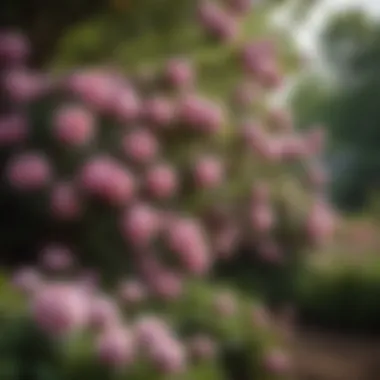Pruning Tree Peonies: A Complete Guide for Growth


Intro
Pruning tree peonies is a fundamental practice for gardeners aiming to enhance the health and aesthetic appeal of these magnificent plants. Unlike their herbaceous counterparts, tree peonies possess unique growth habits and require specific care to flourish. Understanding the intricacies of pruning can significantly influence the quality of blooms and the overall vitality of the shrub.
In this guide, we will explore various aspects of tree peony pruning, including the correct timing, essential techniques, and common misconceptions. The aim is to equip both novice gardeners and seasoned horticulturists with knowledge and skills to prune effectively, ensuring their tree peonies bloom vibrantly year after year.
Understanding Tree Peonies
Tree peonies, with their lush blooms and striking presence, are a vital subject of discussion for both amateur gardeners and landscaping professionals. Understanding the specifics of tree peonies sets the foundation for effective pruning practices, as these shrubs possess unique attributes and challenges. This section delves into essential elements surrounding tree peonies, including their botanical traits, growth habits, and landscape value. By grasping these fundamental concepts, caretakers can cultivate healthier plants that yield more impressive flowers.
Botanical Overview
Tree peonies belong to the genus Paeonia, and they are distinct from their herbaceous counterparts. With their woody stems, tree peonies exhibit a tree-like growth habit. Various species exist, notably Paeonia lutea and Paeonia suffruticosa. The latter is widely appreciated in gardens for its large, vibrant flowers, which can be white, pink, or even deep red. These plants, originating from Asia, require specific conditions to thrive. They prefer well-draining soil and a location that receives ample sunlight while being sheltered from strong winds. Understanding these botanical requirements is crucial for those intending to grow or prune tree peonies successfully.
Growth Habits
Tree peonies have specific growth patterns that significantly influence maintenance practices. Typically, they can reach heights of 3 to 7 feet, depending on the variety and conditions. Their growth rate is moderate, which means patience is necessary when observing the desired results. Established plants develop a bushy appearance with multiple stems arising from the base. Knowing these growth habits is essential for timing and types of pruning, as any missteps can lead to reduced blooms or health issues in the plant. Regular observations allow gardeners to note the stages of growth and act accordingly.
Landscape Value
In landscaping, tree peonies serve as focal points due to their visual appeal. They can elevate the aesthetic of any garden, providing a rich tapestry of colors in spring. These plants are not just pleasing to the eye; they can also attract pollinators, thus benefiting the entire ecosystem. Their structure provides excellent contrast when paired with evergreen species. Furthermore, tree peonies can be used effectively in borders or as standalone specimens. The landscape value of tree peonies is enhanced when one considers their potential companionship with other flowers and plants, leading to more dynamic garden spaces.
"Understanding the unique attributes of tree peonies allows gardeners to make informed decisions regarding care and maintenance, resulting in healthier plants and more vibrant blooms."
In summary, understanding tree peonies is vital for effective care and maintenance. This foundation allows for improved decision-making in pruning and enhancing the overall health and appearance of these beautiful plants.
The Importance of Pruning
Pruning is more than just a routine task in maintaining tree peonies; it is essential for their health and aesthetics. Gardeners often underestimate the impact that proper pruning can have on these magnificent plants. Understanding why pruning matters can profoundly influence the success of cultivating tree peonies. Through effective pruning practices, one can enhance the plant’s overall health, create a more visually appealing landscape, and promote vigorous new growth.
Health Benefits
Pruning contributes significantly to the health of tree peonies. It can help prevent the growth of diseases and pests that often thrive in dense foliage. By removing dead or diseased wood, gardeners decrease the likelihood of fungal infections and insect infestations. This practice allows for better air circulation within the plant, which further helps mitigate potential problems.
Regular pruning may also encourages the development of a stronger structure. By focusing on the removal of weaker stems, you can direct the plant’s energy toward healthier shoots. This results in a more robust root system, ultimately leading to longer-lasting and more resilient plants. In summary, pruning tree peonies is not just about aesthetics; it's a proactive strategy for ensuring that the plants remain healthy and thriving through various seasons.
Aesthetic Considerations
While health is paramount, pruning also plays a crucial role in enhancing the visual appeal of tree peonies. A well-pruned tree peony reflects careful attention to detail that is often admired in garden space. Pruning shapes the plant, helping to maintain a cohesive and balanced form. This visual organization contributes to the overall landscape design, offering a polished look that can impress visitors.
Furthermore, proper pruning allows for a more abundant display of blooms. By judiciously removing old flowers and competing branches, the gardener facilitates an environment that favors blossoming. This is particularly vital for tree peonies, known for their stunning flowers. Well-pruned plants produce larger and more vibrant blooms, providing a spectacle that enhances the ambiance of any garden or outdoor space.
Encouraging New Growth
Another important aspect of pruning tree peonies is the encouragement of new growth. When done correctly, pruning stimulates the plant to produce fresh shoots and foliage. This leads to a healthier plant with improved vitality. New growth is vital for the plant’s ability to absorb nutrients and water more effectively, which ultimately supports greater flower production.
In addition, pruning at the right time can trigger growth cycles that align with the specific needs of tree peonies. For instance, cutting back in early spring can encourage vigorous growth as the plant awakens from dormancy. Seasonal timing is critical in achieving the desired results, making knowledge about the species and its growth patterns essential for effective care.
Proper pruning not only boosts the health of tree peonies but can also magnify their beauty, making them a standout in any garden setting.
When to Prune Tree Peonies
Understanding the right time to prune tree peonies is vital for their health and aesthetics. The timing of pruning affects not just the growth pattern but also the quality of blooms. Proper timing ensures that the peonies can recover from pruning, thereby fostering stronger growth and more vibrant flowers. Delaying pruning or performing it too early might lead to reduced flowering or even plant stress. Instead, knowing when to prune tree peonies helps emphasize their growth cycle while aligning with their specific needs.
Seasonal Timing


Pruning tree peonies should primarily occur during late winter or early spring, before new growth begins. This timing permits the plants to heal from cuts and minimizes any stress caused by the process.
- Late Winter Pruning: As temperatures begin to rise and snow starts to melt, tree peonies benefit from early pruning. This timing minimizes the risk of winter injury since the threat of frost diminishes.
- Early Spring Pruning: Observing the emergence of fresh buds is a good indicator. Pruning as soon as the buds show signs of activity allows for removal of dead or weak stems, thus encouraging robust growth.
- Avoid Fall Pruning: Pruning in the fall could expose plants to unnecessary risks, such as frost damage or disease. Cutting back stems too late can lead to freeze-related injuries, detracting from the plant's vitality.
In essence, choose the late winter or early spring for effective pruning to support your tree peony's growth and blooming potential.
Signs of Necessity
While seasonal timing is crucial, recognizing signs indicating when pruning is necessary can further enhance the health and development of tree peonies. Homeowners should be observant of the following signals:
- Dead or Damaged Stems: Dark, shriveled stems often suggest damage. Removing these ensures that the plant can allocate resources toward healthy growth.
- Thin or Weak Growth: If branches appear spindly or sparse, it's likely that the plant requires pruning. Cutting back these weak areas helps redirect energy toward stronger sections.
- Overcrowding: If the bush looks dense or congested, it could hinder airflow, increasing disease risk. Pruning crowded areas helps improve overall health and aesthetics.
- Lack of Blooms: Even healthy-looking peonies sometimes fail to bloom, indicating a need for pruning. Assessing the plant structure may show areas needing intervention.
Pruning is not only about cutting back but about observing and understanding the plant's needs. Regularly assessing tree peonies will equip homeowners to recognize essential pruning moments.
Pruning Techniques
Pruning techniques are critical for maintaining healthy and vibrant tree peonies. This practice not only contributes to the longevity of the plant but also enhances bloom quality and overall aesthetics. Achieving optimal growth requires understanding the specific methods of pruning and their implications. Each technique serves distinct purposes ranging from health management to aesthetic shaping.
Tools Required
To effectively prune tree peonies, having the right tools is essential. Here are some common tools you should consider:
- Bypass Pruners: Ideal for making clean cuts on live wood without damaging the plant.
- Loppers: Useful for reaching higher branches and thicker stems.
- Hand Saw: For larger or stubborn limbs that cannot be cut with pruners.
- Gardening Gloves: Protect your hands from thorns and other sharp edges.
- Sterilizing Solutions: Disinfect tools to prevent the spread of disease.
Using appropriate tools maintains plant health and makes the pruning process more efficient.
Cutting Methods
When it comes to cutting tree peonies, the method matters. Here are a few key cutting methods:
- Clean Cuts: Ensure that your cuts are made cleanly to avoid tearing the bark. This promotes quicker healing.
- Angle Cuts: An angled cut can help prevent moisture from collecting on the cut surface, reducing the risk of rot.
- Pruning at Different Levels: Different sections of the plant may require cuts at varying heights to promote balanced growth.
Understanding these methods will ensure you maximize the health and beauty of your tree peonies.
Removing Dead Growth
Regularly removing dead or unhealthy branches is a vital part of pruning tree peonies:
- Identify dead growth by looking for branches that are brittle or not producing leaves.
- Cut Back these branches to their base to encourage new growth and improve airflow within the plant.
- Assess the overall structure of the plant, ensuring that remaining branches can thrive without overcrowding.
This practice not only enhances the plant's appearance but also supports its overall vitality.
Shaping the Plant
Shaping the plant is important for both aesthetics and health. Here are techniques that are beneficial:
- Selective Pruning: Focus on branches that create an unnatural shape, maintaining a well-rounded structure.
- Encouraging Air Circulation: By thinning out clusters of branches, you allow sunlight and air to reach each part of the plant. This can prevent disease and promote longer life.
- Balanced Growth: Aim for a symmetrical shape to provide stability and a pleasing appearance in your garden.
By following these shaping techniques, you will enhance not only the look but also the longevity of your tree peonies.
Common Misconceptions About Pruning
Pruning tree peonies often comes with various assumptions that can mislead gardeners. Understanding these misconceptions is important to preserve the health and aesthetics of these plants. Here, we will discuss some of the prominent myths surrounding pruning practices, focusing on why clarity in this area is essential for maintaining vigorous growth and bloom quality.
Over-Pruning Risks
One common myth is that more pruning equals healthier plants. This perception can be harmful. Over-pruning can lead to stunted growth, as tree peonies rely on their foliage for photosynthesis. When too much of the plant is removed, it struggles to generate the energy needed for flower production. If you cut back too drastically, you may also disturb the natural shape of the plant, making it appear uneven or unbalanced.


For instance, cutting back existing stems to a single bud may produce a shorter growth cycle in the following season. This method can result in fewer blooms or even delayed flowering. In some cases, excessive pruning can introduce stress to the plant. It may become more susceptible to pests or diseases, especially if not properly cared for after heavy pruning.
Consider pruning moderately and focusing on strategic cuts to promote air circulation and light penetration without sacrificing the plant's overall structure.
Timing Myths
Another prevalent misconception about pruning is centered on timing. Many believe that pruning must be executed at the same time each year, specifically in early spring. While spring is an optimal time for significant pruning, it is not the only time to consider. The correct timing depends on the local climate and specific tree peony variety.
Pruning should align with the plant's growth cycle. For instance, late winter in milder regions may provide the best opportunity for pruning before new growth begins. Conversely, in regions with harsh winters, pruniing too early can expose the plants to frost damage.
Additionally, some gardeners assume that once a plant is established, pruning can be neglected. This assumption is inaccurate. Regular maintenance at proper intervals enhances the health of the plant and prevents overcrowding.
To summarize, timing is more nuanced than just focusing on a set season. Pay attention to your tree peonies' condition and regional climate for determining the best time to prune.
Post-Pruning Care
Post-pruning care is a critical phase in the growth cycle of tree peonies. It ensures that these plants recover efficiently from the stress of pruning and continue to flourish. Proper care after pruning can significantly influence the overall health of the peonies, their capacity to bloom in the next season, and the vigor of their growth. Observing appropriate watering, fertilization, and regular monitoring can yield remarkable improvements in their vitality.
Watering Requirements
Tree peonies demand particular attention to watering, especially after pruning. It is essential to maintain consistent moisture levels in the soil. Over-watering can lead to root rot, while underwatering can stress the plant, hindering recovery. Ideally, the soil should be kept moist but not soggy.
- Initial Watering: Right after pruning, a deep watering is beneficial. This helps settle the soil around the roots and supports hydration.
- Weekly Checks: Ensure the top inch of soil remains damp. Adjust the watering frequency based on weather conditions. Warm and windy days may necessitate more frequent watering.
Consistent watering, particularly in the first few weeks post-pruning, is crucial for root establishment and new growth.
Fertilization Considerations
After pruning, fertilization is an important consideration to promote strong new growth. Applying the right fertilizers can help replenish any nutrients lost during the pruning process. This should be approached with care and precision.
- Type of Fertilizer: Use a balanced fertilizer, such as a 10-10-10 NPK mix. This ensures that the peonies receive equal parts of nitrogen, phosphorus, and potassium, which are vital for growth and flowering.
- Timing of Application: Fertilizer should generally be applied about four to six weeks after pruning, giving the plants time to redirect energy toward recovery and new growth.
- Application Method: Use granular fertilizers or liquid solutions, avoiding direct contact with the stem to prevent burn.
The proper application of fertilizer can dramatically enhance bloom production and overall plant health.
Monitoring Health
Monitoring the health of tree peonies after pruning is essential for identifying any potential issues early. Regular observation helps catch problems before they escalate, ensuring a robust and beautiful plant.
- Visual Inspections: Check for signs of distress, like wilting, discoloration, or pest presence. Keep an eye out for any fungal issues as well.
- List of Signs to Look For:
- Yellowing leaves can indicate nutrient deficiencies or over-watering.
- Stunted growth may be a sign of insufficient light or poor soil conditions.
- Presence of pests such as aphids or spider mites.
By engaging in consistent monitoring, you can take prompt corrective actions if necessary, ensuring the tree peonies remain healthy and vibrant.
Pruning Tree Peonies in Different Climates
Pruning tree peonies requires an understanding of the unique climate conditions in which they grow. Each climate can affect the timing, techniques, and tools used for this essential horticultural practice. By recognizing these nuances, gardeners can ensure that their tree peonies achieve optimal growth and health. The differences in environmental factors, like temperature, humidity, and sunlight, can greatly impact the lifecycle of these plants.
Factors influencing the approach to pruning include the typical growing season and the anticipated winter dormancy periods. Also, the prevalence of pests and diseases can vary by climate, altering how one might prune for health and resilience. Being aware of these factors can help gardeners avoid unnecessary damage to their plants while still promoting beautiful blooms and vigorous growth.
Comparative Techniques
Different climates require distinct pruning techniques that can adapt to local conditions. For example, in warmer regions, tree peonies may exhibit a longer growing season, allowing for earlier pruning. However, care must be taken to prune before the new shoots begin to swell. In cooler climates, pruning should occur once the risk of frost has passed but before the peonies fully leaf out. The timing thus becomes a critical aspect of successful pruning.
A few comparative techniques for pruning in various climates include:


- Early Spring Pruning: Suitable for regions with milder winters where tree peonies start to break dormancy sooner.
- Late Spring Pruning: If frost is common in your area, late spring is optimal to ensure new growth is not damaged.
- Selective Pruning: In areas prone to disease, selectively removing older or weaker stems can improve air circulation, reducing the likelihood of infection.
It’s beneficial to observe how other gardeners in the local community manage their peonies. This sharing of knowledge can provide insight into what techniques may work best in a particular area.
Regional Adaptations
Understanding regional adaptations is key to successfully pruning tree peonies across diverse environments. Different areas present unique challenges and opportunities for growth. Therefore, incorporating local wisdom alongside standard practices will yield the best outcomes.
For instance, in coastal regions where humidity is high, it may be necessary to prune more aggressively to prevent fungal diseases. Meanwhile, in arid regions, increasing mulch around the base may help retain moisture, making it critical to adjust cutting techniques to minimize stress on the plant.
A few considerations for regional adaptations include:
- Climate Zone Awareness: Familiarize yourself with your USDA Plant Hardiness Zone to tailor pruning practices suitable for your specific climate conditions.
- Water Availability: Adjust pruning methods to conserve water in drier areas, focusing on the removal of less vital branches.
- Soil Conditions: Consider soil type and its nutrient content when deciding how much to prune, as some soils demand less aggressive cutting to maintain overall health.
Managing tree peonies in different climates is an ongoing process that calls for flexibility and attentiveness. Take note of trial and error, as this will provide a pathway for continued improvement and success in maintaining these exquisite plants.
Pruning Tree Peonies for Specific Varieties
Pruning tree peonies requires an understanding of variances among different groups of peony species. Each variety has its own characteristics and needs when it comes to pruning. By focusing on these specific elements, gardeners can enhance the vitality and aesthetic of these plants. It is essential to tailor pruning techniques to the unique growth habits, flower structures, and climatic requirements of each peony variety to ensure they thrive and maintain their beauty.
Hybrid Varieties
Hybrid tree peonies often exhibit unique qualities that make them prized among enthusiasts. These plants are often bred for enhanced color richness and flower size. Understanding how to prune them correctly is vital to keeping their vibrancy and shape intact.
One key consideration in pruning hybrid varieties is the timing. Pruning should be ideally performed in late winter or early spring before the buds swell. This timing encourages robust growth when the plant emerges from dormancy. Additionally, removing any dead or damaged stems promotes overall health and fosters optimal blooming.
When pruning hybrid tree peonies, focus on:
- Thinning out crowded stems: This helps improve air circulation, reducing the risk of fungal diseases.
- Shortening overly long stems: Doing so maintains an attractive shape and encourages bushier growth.
- Health checks: Always evaluate the health of the stems you are pruning, removing any that show signs of disease or pests.
With proper care, hybrid varieties can produce large, showy blossoms each season. Their specific pruning requirements create opportunities for both aesthetic beauty and plant longevity.
Heritage Varieties
Heritage tree peonies, often characterized by their historical and traditional floral attributes, also require distinct pruning techniques. These plants can be quite resilient, but specific considerations help them flourish.
The primary focus in pruning heritage varieties is emphasizing their natural shape while avoiding excessive removal of older wood, as this can hinder blooming potential. The ideal time for pruning heritage peonies is also late winter to early spring. During this period, gardeners should look for:
- Old, woody stems: While some can be removed, ensure not to take out too much old wood at once. Older stems can be more productive in terms of blooms.
- Dead or damaged growth: As with hybrids, removing dead growth helps support new growth.
- Crossing branches: Prevent crowded growth and potential damage by carefully eliminating branches that cross each other.
In summary, honoring the growth habits of heritage peonies leads to established plants that produce beautiful flowers. The nuanced approach to pruning ensures that these treasured varieties continue to be enjoyed for generations.
Epilogue
The conclusion serves as a crucial summary of the insights discussed throughout the article on pruning tree peonies. It encapsulates the importance of implementing effective pruning practices to nurture the health and aesthetic appeal of these remarkable plants. A well-thought-out pruning regimen not only enhances blooming but can significantly improve the overall vitality of tree peonies. Understanding when and how to prune enables gardeners to optimize the growth cycle of these plants.
Key benefits of proper pruning include:
- Improved Plant Health: Regular pruning removes dead or diseased branches, allowing for better airflow and reducing pest issues.
- Enhanced Aesthetics: Shaping the plant through pruning contributes to a neater appearance and encourages a more profuse display of blooms during the flowering season.
- Stimulated New Growth: Pruning encourages the development of fresh shoots, which are essential for robust blooms in the following season.
Moreover, as homeowners and gardening enthusiasts engage with their plants, the knowledge gained emphasizes the significance of consistent maintenance. This commitment fosters not only the beauty of their surroundings but also an enriching gardening experience.
Key Takeaways
- Pruning is essential for maintaining tree peonies' health and beauty.
- Timing and technique are crucial for effective pruning.
- Regular maintenance and observation of the plant leads to thriving blooms.
- Understanding common misconceptions can help master the art of pruning.
Encouragement for Continued Learning
The journey of understanding tree peonies does not end with basic pruning knowledge. Continual learning about horticultural practices can improve skills and enhance the seasonal beauty of gardens. Engage with online communities through platforms like Reddit or Facebook to share experiences and gather insights from fellow enthusiasts. Websites such as en.wikipedia.org and britannica.com also offer reliable information for in-depth research.
"Gardening is a way of showing that you believe in tomorrow."
This sentiment highlights the importance of nurturing plants, understanding their requirements, and adapting methods to embrace new information as it arises.
By keeping abreast of new research and evolving techniques, gardeners can ensure their tree peonies thrive for years to come.



